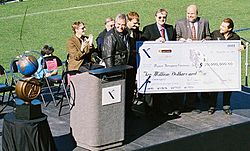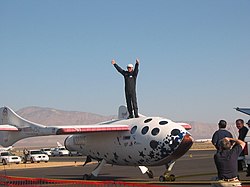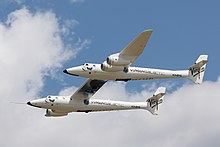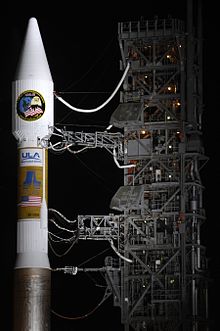 | |
| Founded | 1995 |
|---|---|
| Focus | Public competitions |
| Location | |
Area served
| Energy and environment, exploration, global development, learning, life sciences |
| Method | Revolution through competition |
| Owner | Peter Diamandis |
Key people
| Peter Diamandis, Founder and Executive Chairman Robert K. Weiss, Vice Chairman Anousheh Ansari, CEO |
| Website | www |
Formerly called
| XPRIZE Foundation |
XPRIZE is a nonprofit organization that designs and manages public competitions intended to encourage technological development that could benefit humanity. Their Board of Trustees include James Cameron, Larry Page, Arianna Huffington, Ratan Tata among others.
The XPRIZE mission is to bring about "radical breakthroughs for the benefit of humanity" through incentivized competition. It fosters high-profile competitions to motivate individuals, companies and organizations across all disciplines to develop innovative ideas and technologies that help solve the grand challenges that restrict humanity's progress.
The highest-profile XPRIZE to date was the Ansari X Prize relating to spacecraft development awarded in 2004. This prize was intended to inspire research and development into technology for space exploration.
Background
SpaceShipOne Takeoff
The first, titled the Ansari XPRIZE, was presented on November 6, 2004.
The first XPRIZE – the Ansari XPRIZE – was inspired by the Orteig Prize, a $25,000 prize offered in 1919 by French hotelier Raymond Orteig for the first nonstop flight between New York City and Paris. In 1927, underdog Charles Lindbergh won the prize in a modified single-engine Ryan aircraft called the Spirit of St. Louis. In total, nine teams spent $400,000 in pursuit of the Orteig Prize.
In 1996, entrepreneur Peter Diamandis
offered a $10-million prize to the first privately financed team that
could build and fly a three-passenger vehicle 100 kilometers into space
twice within two weeks. The contest, later titled the Ansari XPRIZE for
Suborbital Spaceflight, motivated 26 teams from seven nations to invest
more than $100 million in pursuit of the $10 million purse. On October
4, 2004, the Ansari XPRIZE was won by Mojave Aerospace Ventures, who successfully completed the contest in their spacecraft SpaceShipOne. The prize was awarded in a ceremony at the Saint Louis Science Center in St. Louis, Missouri. As of 2011, the Science Center maintains numerous exhibits about the XPRIZE.
The foundation has also created the XPRIZE Cup rocket challenge competition.
XPRIZE unifying principles
XPRIZES are monetary rewards to incentivize three primary goals:
- Attract investment from outside the sector that takes new approaches to difficult problems.
- Create significant results that are real and meaningful. Competitions have measurable goals, and are created to promote adoption of the innovation.
- Cross national and disciplinary boundaries to encourage teams around the world to invest the intellectual and financial capital required to solve difficult challenges.
Other organizations such as the Nobel Prize committee award prizes
and financial rewards to individuals or organizations that produce novel
advances in science, medicine and technology. One difference between
the XPRIZES and other similar organizations is awarding prizes based on
the first to achieve objective 'finish line' requirements rather than a
selection committee discussing the relative merits of different
endeavors. For instance, the Archon Genomics XPRIZE
target was to sequence 100 human genomes in 10 days or less, with less
than one error per 100,000 DNA base pairs, covering 98% of the genome
and costing less than $10,000 per genome (this prize was cancelled
because it was outpaced by innovation).
The prize can increase attention to endeavors that otherwise
might not receive much publicity. For example, attempts in the recent
Lunar Lander competition have been well publicized in the media,
increasing visibility of both the foundation and the participants.
With the Ansari XPRIZE, XPRIZE established a model in which
offering a prize for achieving a specific goal can stimulate
entrepreneurial investment. Since then, new challenges have expanded
into a range of other fields. XPRIZE is developing new prizes in
Exploration (Space and Oceans), Life Sciences, Energy & Environment,
Education and Global Development. Some hope the prizes will help
improve lives, create equity of opportunity and stimulate new, important
discoveries.
Prizes and events overseen
As of January 2018, there are seven completed contests, eight active contests and one contest that has been canceled.
Past contests
1996–2004 Ansari XPRIZE for Suborbital Spaceflight
Astronaut Mike Melvill after his award-winning September 29, 2004 spaceflight
The Ansari XPRIZE
for Suborbital Spaceflight was the first prize from the foundation. It
successfully challenged teams to build private spaceships capable of
carrying three people and fly two times within two weeks to open the
space frontier. The first part of the Ansari XPRIZE requirements was fulfilled by Mike Melvill on September 29, 2004 On SpaceShipOne, a spacecraft designed by Burt Rutan and financed by Paul Allen,
co-founder and former CEO of Microsoft. On that ship, Melvill broke the
100-kilometer (62.5 mi) mark, internationally recognized as the
boundary of outer space, winning the prize. Brian Binnie completed the second part
of the requirements on October 4, 2004. As a result, US$10 million was
awarded to the winner, but more than $100 million was invested in new
technologies in pursuit of the prize. Today, Sir Richard Branson, Jeff Bezos and others are creating a personal spaceflight industry.
Awarding this first prize gave XPRIZE as much publicity as the
winners themselves. After the 2004 success there was ample media
coverage to afford both Scaled Composites and XPRIZE additional support
for them to expand and continue to pursue their aims. Following this
early success several other XPRIZES were announced that have yet to be
awarded despite various attempts to meet the requirements.
The Ansari XPRIZE won the Space Foundation's
Douglas S. Morrow Public Outreach Award in 2005. The award is given
annually to an individual or organization that has made significant
contributions to public awareness of space programs.
2007–2010 Progressive Insurance Automotive XPRIZE
The goal of the Progressive Insurance Automotive XPRIZE was to design, build and race super-efficient vehicles that achieve 100 MPGe (2.35 liter/100 kilometer) efficiency, produce less than 200 grams/mile well-to-wheel CO2 equivalent emissions, and could be manufactured for the mass market.
The winners of the competition were announced on September 16, 2010.
- Team Edison2 won the $5 million Mainstream competition with its four-passenger Very Light Car, obtaining 102.5 MPGe running on E85 fuel.
- Team Li-Ion Motors won the $2.5 million Alternative Side-by-Side competition with their aerodynamic Wave-II electric vehicle achieving 187 MPGe.
- Team X-Tracer Switzerland won the $2.5 million Alternative Tandem competition with their 205.3 MPGe faired electric motorcycle.
2010–2011 Wendy Schmidt Oil Cleanup XCHALLENGE
The Wendy Schmidt Oil Cleanup XCHALLENGE was introduced on July 29,
2010. The $1 million prize had a goal to inspire a new generation of
innovative solutions that will speed the pace of cleaning up seawater
surface oil resulting from spillage from ocean platforms, tankers, and
other sources. The team of Elastec/American Marine won the challenge by
developing a device that skims oil off water three times faster than
previously existing technology.
2006–2009 Northrop Grumman Lunar Lander XCHALLENGE
The Northrop Grumman Lunar Lander XCHALLENGE
(NGLLXPC) was a competition (co-hosted by NASA) to build precise,
efficient small rocket systems. It was introduced in 2006 and awarded on
November 5, 2009 in Washington D.C. to Masten Space Systems, led by
David Masten, the top $1 million prize, while Armadillo Aerospace, led
by id Software founder John Carmack took home the second place prize of
$500,000, plus an additional $500,000 in 2008.
2012–2014 The Nokia Sensing XCHALLENGE
The
Nokia Sensing XCHALLENGE goal is accelerating the use of sensors and
sensing technology to tackle health care problems and find ways for
people to monitor and maintain their personal well-being. It was
composed of two distinct Challenges held in 2013 and 2014. It was
announced in 2012 and 12 finalists announced in 2013. On November 11, 2014 the winner was named and prize purses totaling $2.25 million were awarded.
2013–2015 The Wendy Schmidt Ocean Health XPRIZE
The Wendy Schmidt Ocean Health XPRIZE is a $2 million competition to improve our understanding of ocean acidification. On July 20, 2015 the winners of the challenge were announced.
2011–2017 Tricorder XPRIZE
The Qualcomm Tricorder XPRIZE was announced on May 10, 2011, and is sponsored by Qualcomm Foundation. It was officially launched on January 10, 2012.
The $10 million prize is awarded for creating a mobile device that can
"diagnose patients better than or equal to a panel of board certified
physicians". The name is taken from the tricorder device in Star Trek which can be used to instantly diagnose ailments.
2007–2018 Google Lunar XPRIZE
The Google Lunar XPRIZE
was introduced on September 13, 2007. The goal of the prize was similar
to that of the Ansari XPRIZE, to inspire a new generation of private
investment in space exploration and technology. The challenge called for
teams to compete in successfully launching, landing, and operating a
rover on the lunar surface.
The prize was going to award $20 million to the first team to land a
rover on the moon that successfully roved more than 500 meters and
transmitted back high definition images and video. There was a $5
million second prize, as well as $5 million in potential bonus prizes
for extra features such as roving long distances (greater than 5,000
meters) capturing images of man-made objects on the moon, or surviving a
lunar night.
On January 23, 2018, the prize ended when no team was able to
schedule, confirm and pay for a launch attempt. The X Prize Foundation
announced that "no team would be able to make a launch attempt to reach
the Moon by the 31 March 2018 deadline... and the US$30 million Google
Lunar XPRIZE will go unclaimed."
2016-2018 Water Abundance XPRIZE
On
October 20, 2018, the XPRIZE Foundation awarded The Water Abundance
XPRIZE, which launched on October 24, 2016 with a purse of $1.75 million
provided by the Tata Group and Australian Aid,
to the Skysource/Skywater Alliance based in Venice, California, who
received a grand prize of $1.5 million. An additional award of $150,000
went to the second place team, JMCC WING, based in South Point, Hawaii,
to acknowledge the team’s ingenuity in developing a unique technological
approach. Over a 24 hour period, the Skysource/Skywater Alliance successfully
extracted over 2,000 liters of water using only renewable energy, at a
cost of USD $0.02 per liter. The team, led by architect David Hertz, intends to use the award to
productize the system to address water scarcity in the developing world.
Canceled contests
2006–2013 Archon Genomics XPRIZE
The Archon Genomics XPRIZE, the second XPRIZE to be offered by the
foundation, was announced October 4, 2006. The goal of the Archon
Genomics XPRIZE was to greatly reduce the cost and increase the speed of
human genome
sequencing to create a new era of personalized, predictive and
preventive medicine, eventually transforming medical care from reactive
to proactive. The $10 million prize purse was promised to the first team
that can build a device and use it to sequence 100 human genomes within
10 days or less, with an accuracy of no more than one error in every
100,000 bases sequenced, with sequences accurately covering at least 98%
of the genome, and at a recurring cost of no more than $1,000 per genome.
If more than one team attempted the competition at the same time,
and more than one team fulfilled all the criteria, then teams would
have been ranked according to the time of completion. No more than three
teams would have been ranked and would have shared the purse in the
following manner: $7.5 million to the winner and $2.5 million to the
second place team if two teams were successful, or $7 million, $2
million and $1 million if three teams are successful.
Actual competition events were originally scheduled to take place
twice a year with all eligible teams given the opportunity to make an
attempt, starting at precisely the same time as the other teams. This
was changed to a single competition scheduled for September 5, 2013 to
October 1, 2013, which was canceled on August 22, 2013. The rationale
for the change was articulated by the CEO: "Today, companies can do this
for less than $5,000 per genome, in a few days or less – and are moving
quickly towards the goals we set for the prize. For this reason, we
have decided to cancel an XPRIZE for the first time ever." A public debate concerning the validity and potential implications of the cancellation was published March 27, 2014.
Active contests
2014 The Global Learning XPRIZE
The
Global Learning XPRIZE, launched in September 2014, is a $15-million
prize to create mobile apps to improve reading, writing, and arithmetic
in developing nations. Each application will be developed during an
18-month period and the top five teams will receive $1 million each,
with each of the winning apps being made available under an open source
license. The finalist of the group, that then develops an app producing
the highest performance gains, will win an additional $10 million top
prize.
2014 IBM Watson A.I. XPRIZE
The A.I. XPRIZE was announced as having an aim to use an artificial intelligence system to deliver a compelling TED
talk. Diamandis hopes to contrast the benevolent value of AI against
the dystopian point of view that sometimes enter AI conversations. The
winning team of the contest, which is scheduled for 2020, will be
determined by the audience.
2015 Shell Ocean Discovery XPRIZE
On
December 14, 2015, Peter Diamandis, chairman and CEO of X Prize,
announced the launch of a new $7 million prize that will be a three-year
global competition that challenges researchers to build better
technologies for mapping Earth's seafloor.
2015 NRG Cosia Carbon XPRIZE
On
September 29, 2015, Peter Diamandis, chairman and CEO of X Prize,
announced the launch of a $20 million prize for a 4.5-year competition
on testing technologies which converts CO2 into products with the highest net value to reduce carbon dioxide emissions of either a coal or a natural gas power plant.
Round three began in April 2018 as the 27 semifinalists were cut down
to ten finalists; each receiving an equal share of $5 million milestone
prize money. Five teams will compete at in coal-fired power plant in Gillette, Wyoming and the remaining five teams will compete at a natural gas-fired power plant in Alberta, Canada. In February 2020 this operational round will conclude and winners will be announced the following month.
2015 Adult Literacy XPRIZE
Find solutions how to improve literacy proficiency of adults in reading within a 12-month period.
The challenge has been announced on June 8, 2015 and is awarded with $7 million by Barbara Bush Foundation for Family Literacy and the Dollar General Literacy Foundation. The winners will be announced in January 2019.
The Anu & Naveen Jain
Women's Safety XPRIZE was launched on October 24, 2016 and has a $1
million purse. The goal for competing teams is to develop a safety
device for women that can autonomously and inconspicuously trigger an
emergency alert while transmitting information to a network of community
responders.
2018 ANA Avatar XPRIZE
The $10 million ANA
Avatar XPRIZE is a four-year competition focused on accelerating the
integration of emerging and exponential technologies into a multipurpose
avatar system that will seamlessly transport human skills and
experience to the exact location where and when they are needed.
Xprize Foundation India
Considering the potential of Indian talent, X Prize Foundation set up a trust/NGO in November 2014 in Mumbai, India.
Board of Directors
The
XPRIZE Foundation is governed by a Board of Directors that determine
the annual roadmaps and act as stewards for the Foundation. As of
January 2018, the Board of Directors are:
- Anousheh Ansari, Director.
- Amir Ansari, Director.
- Avi Reichental, Director
- Jack Bader, Director.
- Peter Diamandis, Founder and Executive Chairman.
- Gil Elbaz, Director.
- Eric Esrailian, Director.
- John B. Frank, Director.
- Salim Ismail, Director.
- James Manyika, Director
- Gregg E. Maryniak, Secretary.
- Lauren Selig, Director.
- Jeffrey L. Shames, Director.
- Marcus Shingles, Fmr. Chief Executive Officer.
- J. Barry Thompson, Treasurer.
- Robert K. Weiss, Vice Chairman.
Board of Trustees
The
XPRIZE Foundation also has a Board of Trustees that provides insights
on new technologies, grand challenges requiring significant innovation,
and other areas that lend themselves to prize philanthropy. A sample of
the Trustees includes:
- James Cameron, Trustee.
- Jim Gianopulos, Trustee.
- Arianna Huffington, Trustee.
- Dean Kamen, Trustee.
- Ray Kurzweil, Trustee.
- Erik Lindbergh, Trustee.
- Larry Page, Trustee.
- Ratan Tata, Trustee.
















